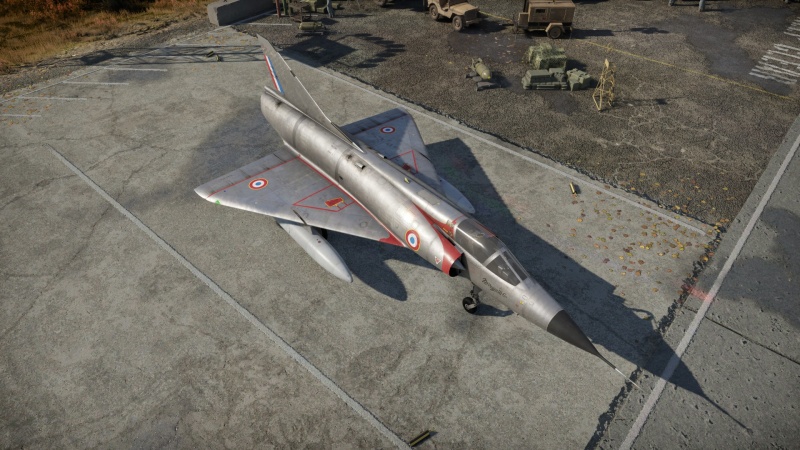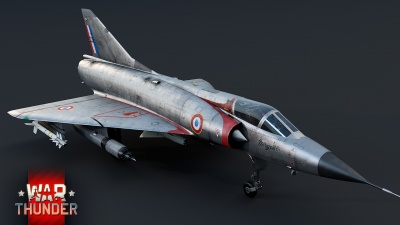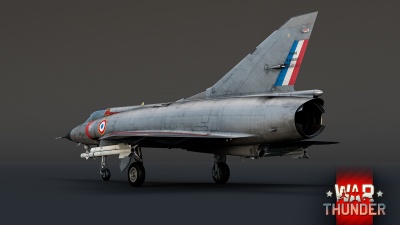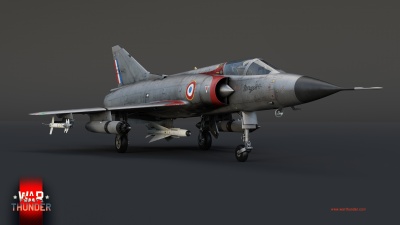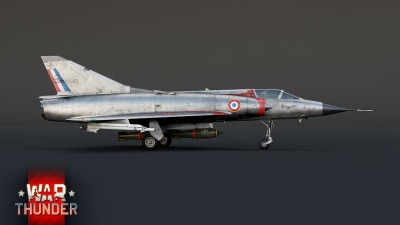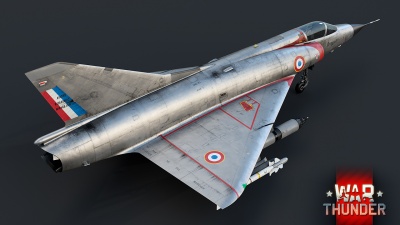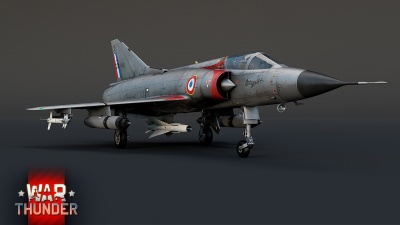Difference between revisions of "Mirage IIIC"
(→Flight performance) |
(The History portion of this page seemed to have been written by someone for whom English isn't their primary language, so I cleaned up grammar and the writing flow. Also added in a few links to other delta-wing aircraft in WT and the Dassault website.) (Tag: Visual edit) |
||
| Line 13: | Line 13: | ||
{{Specs-Avia-Flight}} | {{Specs-Avia-Flight}} | ||
<!-- ''Describe how the aircraft behaves in the air. Speed, manoeuvrability, acceleration and allowable loads - these are the most important characteristics of the vehicle.'' --> | <!-- ''Describe how the aircraft behaves in the air. Speed, manoeuvrability, acceleration and allowable loads - these are the most important characteristics of the vehicle.'' --> | ||
| − | The Mirage IIIC has one of the best joystick handling characteristics of any aircraft in War Thunder, with the capability to perform a Kulbit, which is essentially a backflip in forward flight. Unlike the [[J35D|J35]] "Draken" it retains superb handling characteristics in a deep stall, allowing rapid-reaction vector-thrust-like | + | The Mirage IIIC has one of the best joystick handling characteristics of any aircraft in War Thunder, with the capability to perform a Kulbit, which is essentially a backflip in forward flight. Unlike the [[J35D|J35]] "Draken" it retains superb handling characteristics in a deep stall, allowing rapid-reaction vector-thrust-like maneuverability albeit the yaw control being commanded by the inverse roll control axis. It also does not suddenly transition from lack of elevator authority to excessive pitch-up authority like the [[J35D|J35]] but joystick pilots will still need to monitor their airspeed so sudden maneuvering does not result in an Over-G wing stress or an unwanted cobra. The Mirage III also as a result of its low stall speed (100 knots, 185 km/h) is capable of tight turns only beaten by the [[J35D|J35]] however it has superb maneuvering energy retention whilst on joystick, with the capacity to bleed speed at will, resulting in what is potentially, an irreversible supersonic fighter in the hands of a veteran pilot. |
| − | New pilots may find assistance | + | New pilots may find assistance utilizing the Stability Augmentation System (SAS) mode set to dampening to prevent unwanted stalls. Additionally, setting pitch-axis multiplier down to less than 0.95 will also aid with unwanted Over-G wing stress situations. |
It should be noted that the Mirage IIIE has differing flight characteristics to the Mirage IIIC, in that the IIIE flight model has heavier moment of inertia, resulting in sluggish control input. | It should be noted that the Mirage IIIE has differing flight characteristics to the Mirage IIIC, in that the IIIE flight model has heavier moment of inertia, resulting in sluggish control input. | ||
| Line 111: | Line 111: | ||
{{Specs-Avia-Armour}} | {{Specs-Avia-Armour}} | ||
<!-- ''Examine the survivability of the aircraft. Note how vulnerable the structure is and how secure the pilot is, whether the fuel tanks are armoured, etc. Describe the armour, if there is any, and also mention the vulnerability of other critical aircraft systems.'' --> | <!-- ''Examine the survivability of the aircraft. Note how vulnerable the structure is and how secure the pilot is, whether the fuel tanks are armoured, etc. Describe the armour, if there is any, and also mention the vulnerability of other critical aircraft systems.'' --> | ||
| − | The Mirage IIIC has no | + | The Mirage IIIC has no armor and is very susceptible to damage. Hits that do not outright destroy the aircraft will severely hamper maneuverability and performance. A damaged engine will require immediate landing, since the aircraft loses a lot of energy while turning, the loss of power will be very noticeable. Wing or tail/rudder damage will result in flatspins if the aircraft is taken to low speeds or if too many G's are pulled. |
| − | Overall, if damaged, a pilot should seek to land as soon as possible while attempting to make as few | + | Overall, if damaged, a pilot should seek to land as soon as possible while attempting to make as few maneuvers as possible. |
=== Modifications and economy === | === Modifications and economy === | ||
| Line 162: | Line 162: | ||
'''When in air battles:''' | '''When in air battles:''' | ||
| − | The Mirage IIIC is one of the most feared planes in the sky, not only because of its speed but because of its powerful air-to-air missiles. However, the Mirage lacks "ACM" (Air Combat | + | The Mirage IIIC is one of the most feared planes in the sky, not only because of its speed but because of its powerful air-to-air missiles. However, the Mirage lacks "ACM" (Air Combat Maneuvering) bore-sight lock capability, and thus it must "search" then "acquire lock" before being able to slave a missile to its radar, which can be exceedingly frustrating to use for joystick pilots, where the uncaged seeker of the Matra Magic missile will often lose lock without radar slaving assistance. |
The Mirage has a wide range of AAMs featuring both IR seeker and radar-guided missiles: the AIM-9B, Matra R550 Magic 1, Matra R530E and the Matra R530. Each of the missiles has its pros and cons which will be explained. It should be noted that the Mirage '''should not be used as a bomber in Air Realistic battles''' due to its mediocre bomb payload. | The Mirage has a wide range of AAMs featuring both IR seeker and radar-guided missiles: the AIM-9B, Matra R550 Magic 1, Matra R530E and the Matra R530. Each of the missiles has its pros and cons which will be explained. It should be noted that the Mirage '''should not be used as a bomber in Air Realistic battles''' due to its mediocre bomb payload. | ||
| Line 168: | Line 168: | ||
''AIM-9B:'' | ''AIM-9B:'' | ||
| − | This is one of the most universal and basic IR AAM which is available in many nations. Although they are one of the easiest missiles to evade, their speed and range make them deadly against unaware enemies. | + | This is one of the most universal and basic IR AAM which is available in many nations. Although they are one of the easiest missiles to evade, their speed and range make them deadly against unaware or low-energy enemies. |
''Matra R550 Magic 1:'' | ''Matra R550 Magic 1:'' | ||
| − | This is | + | This is an IR AAM unique to France which is hard to evade without the use of flares due to its high speed, G-limit and firing range. They are similar to the [[SRAAM]] missiles in terms of use due to its G-limit. The main difference is that the R550 does not have a thrust vectoring system, meaning it has to gain speed when launched in order to make turns which differs from SRAAM which can turn while gaining speed in super short distances (less than 1 km but greater than 200 m) due to the vectoring thrust. |
''Matra R530E:'' | ''Matra R530E:'' | ||
| Line 203: | Line 203: | ||
* Bleeds energy at high angles of attack | * Bleeds energy at high angles of attack | ||
* Relatively low thrust to weight ratio compared to its peers | * Relatively low thrust to weight ratio compared to its peers | ||
| − | * No | + | * No armor |
* Oldest/weakest engine of all current top-rank planes | * Oldest/weakest engine of all current top-rank planes | ||
* Can't accelerate from dogfight in time | * Can't accelerate from dogfight in time | ||
| − | * No flares | + | * No flares or RWR |
| − | |||
== History == | == History == | ||
<!-- ''Describe the history of the creation and combat usage of the aircraft in more detail than in the introduction. If the historical reference turns out to be too long, take it to a separate article, taking a link to the article about the vehicle and adding a block "/History" (example: <nowiki>https://wiki.warthunder.com/(Vehicle-name)/History</nowiki>) and add a link to it here using the <code>main</code> template. Be sure to reference text and sources by using <code><nowiki><ref></ref></nowiki></code>, as well as adding them at the end of the article with <code><nowiki><references /></nowiki></code>. This section may also include the vehicle's dev blog entry (if applicable) and the in-game encyclopedia description (under <code><nowiki>=== In-game description ===</nowiki></code>, also if applicable).'' --> | <!-- ''Describe the history of the creation and combat usage of the aircraft in more detail than in the introduction. If the historical reference turns out to be too long, take it to a separate article, taking a link to the article about the vehicle and adding a block "/History" (example: <nowiki>https://wiki.warthunder.com/(Vehicle-name)/History</nowiki>) and add a link to it here using the <code>main</code> template. Be sure to reference text and sources by using <code><nowiki><ref></ref></nowiki></code>, as well as adding them at the end of the article with <code><nowiki><references /></nowiki></code>. This section may also include the vehicle's dev blog entry (if applicable) and the in-game encyclopedia description (under <code><nowiki>=== In-game description ===</nowiki></code>, also if applicable).'' --> | ||
=== Post-war French aviation === | === Post-war French aviation === | ||
| − | + | After the Second World War, the French aviation design community was still in ruins. While research had continued during the war, the destruction of factories and breakup of research teams had caused French designs to lag behind. The first design built by France after the Second World War was the famous VB.10 fighter, which completed its first flight mission in 1947, though the original design work was started in 1940 and interrupted by the German invasion. Even though the French designers were eager to get back to designing aircraft for their nation, the government still couldn't provide enough money and resources to help them achieve their dreams, so the French Air Force was still equipped with American F-84 Thunderjets and British Vampires at the beginning of the Cold War. The SNCASE company also chose to buy the production license for the de Havilland Vampire fighter, naming it "Mistral". | |
| − | Those early American and British designs helped the French designers learn about jet fighters, | + | Those early American and British designs helped the French designers learn about jet fighters, and soon thereafter they were able to launch a series of successful works such as the SO.4050 Vautour, MD.452 Mystère II, MD.454 Mystère IVA, and Super Mystère B.2 in the 1950s. However, soon afterwards the American F-100 Super Saber and Soviet MiG-19 fighter entered into service in 1954 and 1955, leaving the French Air Force with only subsonic designs. Even the latest Super Mystère B.2 could only break the speed of sound in a dive, and so the French Air Force bought North American F-100D fighters as a stopgap measure. |
| − | + | However, the French designers wouldn't be beaten a second time. Marcel Ferdinand Bloch, designer of the famous MB.152 piston fighter, had been captured by Germans during the Second World War because of his Jewish identity, but was saved by the US Third Army in 1945. After that, Bloch changed his last name to Char D'Assault to honor his brother's Resistance service under the same name. In 1947, the Dassault company received their first order from French Air Force to build three prototype planes, and the first of them successfully flew in 1949. The duration of the entire development work was only 18 months, with the new fighter being named MD.450 Ouragan. The aircraft was introduced into service in 1952. | |
| − | Their second product, MD.452 Mystère II was based on their previous fighter design and used swept | + | Their second product, MD.452 Mystère II, was based on their previous fighter design and used a swept wing to improve the flight performance. The MD.454 Mystère IVA was one of the most famous products made by Dassault company during the 1950s. The aircraft was used by the Israel Air Force during the Suez Canal War in 1956 and successfully combated Egyptian MiG-15 fighters. |
=== The tale of "Mirage" === | === The tale of "Mirage" === | ||
| − | In response to the challenge of the Soviet Union's new Mach 2 | + | In response to the challenge of the Soviet Union's new Mach 2 MiG-21 which would enter into service in 1960, Dassault designed the MD.550 Mystère-Delta program, which was usually misunderstood by the public as a design born on the basis of the Super Mystère B.2 fighter. In fact, it was born based on an improved version of the Mystère IV fighter, and there was no direct relationship between it and the Super Mystère B.2. Initially competing with Dassault's MD.550 project were the Nord 1500 Griffon, SE-212 Durandal, and SO.9050 Trident II projects, but the Mystère-Delta stood out and soon received an order from the French Air Force for two prototypes. |
| − | In 1956, after the first design changes, the Mystère-Delta prototype was renamed | + | In 1956, after the first design changes, the Mystère-Delta prototype was renamed the Mirage I. The aircraft only had one air-to-air missile as its primary weapon, and only achieved Mach 1.6 during the flight test, even after it utilized the built-in rocket motor. To achieve the goal of reaching Mach 2 speed in level flight, Dassault changed the main design again, including a change in fixed air intake design to a variable air intake design and the introduction of the area rule design. The Mirage I design was eventually abandoned, and the Mirage II fighter was designed to use Turboméca Gabizo afterburning turbojets along with a pair of the SEPR rocket motors, but it was cancelled and never built. |
| − | The final design which | + | The final design which entered into service in 1961 was called the Mirage III, and the first truly mass production version was called Mirage IIIC with the A version only used for research propose, and the B being built as a training version. The basic weapon used on the Mirage IIIC fighter was the DEFA 552 30 mm canno, two of which were mounted on the aircraft and could carry 250 rounds in total. Dassault also introduced the Matra R.530 radar or infrared-guided medium-range air-to-air missile to the aircraft, which had a maximum firing range of 18 km and maximum maneuvering overload of 12G. The Mirage IIIC fighter also carried two AIM-9B Sidewinder infrared-guided short-range air-to-air missile for WVR combat in the 1960s. In 1975, the famous Matra R.550 Magic 1 infrared-guided short-range air-to-air missile with a maximum maneuvering overload of 35G (30G ingame) entered into service, with both the Mirage III fighter and Mirage F.1 fighters being upgraded with the capability to launch the missile. |
| − | For the ground attack role, the Mirage IIIC fighter can use unguided bombs and SNEB 68 mm | + | For the ground attack role, the Mirage IIIC fighter can use unguided bombs and SNEB 68 mm rockets, with the Nord AS.20 and AS.30 radio-guided air-to-ground missiles also being good choices for the pilot. However, only one of the Nord missiles can be equipped at a time under the fuselage. |
| − | As for the avionics, Mirage IIIC | + | As for the avionics, the Mirage IIIC was initially equipped with a Cyrano I bis search and fire-control radar, later it was upgraded to Cyrano IIA radar with improved performance. After entering into service in 1961, the Cyrano radar suffered many technical problems which led to the fact that the first 25 Mirage IIICs didn't receive the system when they entered into service. The Cyrano I bis and Cyrano IIA radar only have air-to-air capacity, air-to-ground capability like the ground-mapping mode was added into the Cyrano IIB radar which was installed into Australian Mirage IIIO fighter and later versions. The Mirage IIIC fighter was also one of the firstWestern military aircraft design to utilize a heads-up display from the beginning in the form of the CSF95. The Mirage IIIC was also one of the first European designs which equipped the Crouzet 20 Central Air Data Computer. with the BAC Lightning only receiving its own Central Air Data Computer from the F.2A version. |
| − | The power plant of the Mirage IIIC fighter | + | The power plant of the Mirage IIIC fighter is the SNECMA Atar 9B turbojet engine. The pilot can choose to equip the SEPR 841 auxiliary rocket motor to improve the flight performance at high altitude, though this removes the two DEFA cannons. |
=== [[wt:en/news/6728-development-mirage-iiic-an-illusive-figure-en|Devblog]] === | === [[wt:en/news/6728-development-mirage-iiic-an-illusive-figure-en|Devblog]] === | ||
| Line 269: | Line 268: | ||
* ''reference to the series of the aircraft;'' | * ''reference to the series of the aircraft;'' | ||
* ''links to approximate analogues of other nations and research trees.'' --> | * ''links to approximate analogues of other nations and research trees.'' --> | ||
| − | + | * [[Mirage IIIE]], an improved version of the aircraft. | |
| − | + | * Other delta-wing aircraft such as the British [[Javelin F.(A.W.) Mk.9]] and the Swedish [[J35D]]. | |
| − | |||
| − | * | ||
== External links == | == External links == | ||
| Line 281: | Line 278: | ||
* [[wt:en/news/6728-development-mirage-iiic-an-illusive-figure-en|[Devblog] Mirage IIIC: An Illusive Figure]] | * [[wt:en/news/6728-development-mirage-iiic-an-illusive-figure-en|[Devblog] Mirage IIIC: An Illusive Figure]] | ||
| + | * https://www.dassault-aviation.com/en/passion/aircraft/military-dassault-aircraft/mirage-iii/ | ||
{{AirManufacturer Bloch}} | {{AirManufacturer Bloch}} | ||
{{France jet aircraft}} | {{France jet aircraft}} | ||
Revision as of 21:41, 31 August 2021
Contents
Description
The Mirage IIIC is a rank VII French jet fighter with a battle rating of 10.3 (AB/SB) and 10.0 (RB). It was introduced in Update "Starfighters".
General info
Flight performance
The Mirage IIIC has one of the best joystick handling characteristics of any aircraft in War Thunder, with the capability to perform a Kulbit, which is essentially a backflip in forward flight. Unlike the J35 "Draken" it retains superb handling characteristics in a deep stall, allowing rapid-reaction vector-thrust-like maneuverability albeit the yaw control being commanded by the inverse roll control axis. It also does not suddenly transition from lack of elevator authority to excessive pitch-up authority like the J35 but joystick pilots will still need to monitor their airspeed so sudden maneuvering does not result in an Over-G wing stress or an unwanted cobra. The Mirage III also as a result of its low stall speed (100 knots, 185 km/h) is capable of tight turns only beaten by the J35 however it has superb maneuvering energy retention whilst on joystick, with the capacity to bleed speed at will, resulting in what is potentially, an irreversible supersonic fighter in the hands of a veteran pilot.
New pilots may find assistance utilizing the Stability Augmentation System (SAS) mode set to dampening to prevent unwanted stalls. Additionally, setting pitch-axis multiplier down to less than 0.95 will also aid with unwanted Over-G wing stress situations.
It should be noted that the Mirage IIIE has differing flight characteristics to the Mirage IIIC, in that the IIIE flight model has heavier moment of inertia, resulting in sluggish control input.
| Characteristics | Max Speed (km/h at 12,000 m) |
Max altitude (metres) |
Turn time (seconds) |
Rate of climb (metres/second) |
Take-off run (metres) | |||
|---|---|---|---|---|---|---|---|---|
| AB | RB | AB | RB | AB | RB | |||
| Stock | 2,087 | 2,045 | 16000 | 29.5 | 30.1 | 109.3 | 97.7 | 750 |
| Upgraded | 2,238 | 2,160 | 26.7 | 28.0 | 173.1 | 140.0 | ||
Details
| Features | |||||
|---|---|---|---|---|---|
| Combat flaps | Take-off flaps | Landing flaps | Air brakes | Arrestor gear | Drogue chute |
| X | X | X | ✓ | X | ✓ |
| Limits | ||||||
|---|---|---|---|---|---|---|
| Wings (km/h) | Gear (km/h) | Flaps (km/h) | Max Static G | |||
| Combat | Take-off | Landing | + | - | ||
| 0 | 426 | N/A | N/A | N/A | ~12 | ~5 |
| Optimal velocities (km/h) | |||
|---|---|---|---|
| Ailerons | Rudder | Elevators | Radiator |
| < 920 | < 750 | < 650 | N/A |
Engine performance
| Engine | Aircraft mass | |||||
|---|---|---|---|---|---|---|
| Engine name | Number | Basic mass | Wing loading (full fuel, no booster) | |||
| SNECMA Atar 9B | 1 | 6,340 kg | 258 kg/m2 | |||
| Engine characteristics | Mass with fuel (no weapons load, no booster) | Max Takeoff Weight | ||||
| Weight (each) | Type | 8m fuel | 20m fuel | 28m fuel | ||
| 1,450 kg | Afterburning axial-flow turbojet | 6,900 kg | 7,673 kg | 8,206 kg | 10,950 kg | |
| Maximum engine thrust @ 0 m (RB/SB) | Thrust to weight ratio @ 0 m (WEP, no booster) | |||||
| Condition | 100% | WEP | 8m fuel | 20m fuel | 28m fuel | MTOW |
| Stationary | 4,230 kgf | 6,090 kgf | 0.88 | 0.79 | 0.74 | 0.56 |
| Optimal | 5,118 kgf (1,200 - 1,400 km/h) |
8,253 kgf (1,400 km/h) |
1.20 | 1.08 | 1.01 | 0.75 |
Survivability and armour
The Mirage IIIC has no armor and is very susceptible to damage. Hits that do not outright destroy the aircraft will severely hamper maneuverability and performance. A damaged engine will require immediate landing, since the aircraft loses a lot of energy while turning, the loss of power will be very noticeable. Wing or tail/rudder damage will result in flatspins if the aircraft is taken to low speeds or if too many G's are pulled.
Overall, if damaged, a pilot should seek to land as soon as possible while attempting to make as few maneuvers as possible.
Modifications and economy
Armaments
Suspended armament
The Mirage IIIC can be outfitted with the following ordnance:
- 2 x 30 mm DEFA 552A cannons (125 rpg = 250 total)
- 2 x 30 mm DEFA 552A cannons + 2 x AIM-9B Sidewinder missiles
- 2 x 30 mm DEFA 552A cannons + 1 x Matra R530E missile
- 2 x 30 mm DEFA 552A cannons + 1 x Matra R530 missile
- 2 x 30 mm DEFA 552A cannons + 2 x Matra R550 Magic 1 missiles
- 2 x 30 mm DEFA 552A cannons + 1 x Matra R530E missile + 2 x AIM-9B Sidewinder missiles
- 2 x 30 mm DEFA 552A cannons + 1 x Matra R530E missile + 2 x Matra R550 Magic 1 missiles
- 2 x 30 mm DEFA 552A cannons + 1 x Matra R530E missile + 36 x SNEB type 23 rockets + 2 x AIM-9B Sidewinder missiles
- 2 x 30 mm DEFA 552A cannons + 1 x Matra R530E missile + 36 x SNEB type 23 rockets + 2 x Matra R550 Magic 1 missiles
- 2 x 30 mm DEFA 552A cannons + 1 x Matra R530 missile + 2 x AIM-9B Sidewinder missiles
- 2 x 30 mm DEFA 552A cannons + 1 x Matra R530 missile + 2 x Matra R550 Magic 1 missiles
- 2 x 30 mm DEFA 552A cannons + 1 x Matra R530 missile + 36 x SNEB type 23 rockets + 2 x AIM-9B Sidewinder missiles
- 2 x 30 mm DEFA 552A cannons + 1 x Matra R530 missile + 36 x SNEB type 23 rockets + 2 x Matra R550 Magic 1 missiles
- 2 x 30 mm DEFA 552A cannons + 1 x AS-30 Nord missile + 36 x SNEB type 23 rockets
- 2 x 30 mm DEFA 552A cannons + 1 x AS-30 Nord missile + 72 x SNEB type 23 rockets
- 2 x 30 mm DEFA 552A cannons + 2 x 250 kg SAMP Type 25 bombs (500 kg total)
- 2 x 30 mm DEFA 552A cannons + 2 x 400 kg SAMP Type 21 bombs (800 kg total)
- 2 x 30 mm DEFA 552A cannons + 2 x 250 kg SAMP Type 25 bombs + 2 x AIM-9B Sidewinder missiles (500 kg total)
- 2 x 30 mm DEFA 552A cannons + 2 x 250 kg SAMP Type 25 bombs + 2 x Matra R550 Magic 1 missiles (500 kg total)
- 2 x 30 mm DEFA 552A cannons + 2 x 250 kg SAMP Type 25 bombs + 36 x SNEB type 23 rockets (500 kg total)
- 2 x 30 mm DEFA 552A cannons + 2 x 250 kg SAMP Type 25 bombs + 72 x SNEB type 23 rockets (500 kg total)
- 2 x 30 mm DEFA 552A cannons + 2 x 400 kg SAMP Type 21 bombs + 2 x AIM-9B Sidewinder missiles (800 kg total)
- 2 x 30 mm DEFA 552A cannons + 2 x 400 kg SAMP Type 21 bombs + 2 x Matra R550 Magic 1 missiles (800 kg total)
- 2 x 30 mm DEFA 552A cannons + 2 x 400 kg SAMP Type 21 bombs + 36 x SNEB type 23 rockets (800 kg total)
- 2 x 30 mm DEFA 552A cannons + 2 x 400 kg SAMP Type 21 bombs + 72 x SNEB type 23 rockets (800 kg total)
- 2 x AIM-9B Sidewinder missiles
- 2 x Matra R550 Magic 1 missiles
Usage in battles
The Mirage IIIC is a multirole strike fighter which can be used in a wide variety of roles from air-to-air and a really limited role in air-to-ground.
When in air battles:
The Mirage IIIC is one of the most feared planes in the sky, not only because of its speed but because of its powerful air-to-air missiles. However, the Mirage lacks "ACM" (Air Combat Maneuvering) bore-sight lock capability, and thus it must "search" then "acquire lock" before being able to slave a missile to its radar, which can be exceedingly frustrating to use for joystick pilots, where the uncaged seeker of the Matra Magic missile will often lose lock without radar slaving assistance.
The Mirage has a wide range of AAMs featuring both IR seeker and radar-guided missiles: the AIM-9B, Matra R550 Magic 1, Matra R530E and the Matra R530. Each of the missiles has its pros and cons which will be explained. It should be noted that the Mirage should not be used as a bomber in Air Realistic battles due to its mediocre bomb payload.
AIM-9B:
This is one of the most universal and basic IR AAM which is available in many nations. Although they are one of the easiest missiles to evade, their speed and range make them deadly against unaware or low-energy enemies.
Matra R550 Magic 1:
This is an IR AAM unique to France which is hard to evade without the use of flares due to its high speed, G-limit and firing range. They are similar to the SRAAM missiles in terms of use due to its G-limit. The main difference is that the R550 does not have a thrust vectoring system, meaning it has to gain speed when launched in order to make turns which differs from SRAAM which can turn while gaining speed in super short distances (less than 1 km but greater than 200 m) due to the vectoring thrust.
Matra R530E:
This IR AAM has a tremendous explosive power, speed, and firing range. Despite not being the most agile AAM in the game, they are the best IR long range AAM. This comes with a cost, the Mirage only has access to 1 carried on the belly pylon. This missile should only be used when chasing enemy planes in a run, not while turning. The main downside is fighting against planes with Infrared Countermeasures (IRCM) and Missile Alert Warning (MAW) which will automatically dump flares upon detecting the missile.
Matra R530:
This is the biggest radar-guided AAM in the game, exactly the same as the R530E but with radar guidance and without a maximum lock-on range in rear aspect, meaning it can be fired at any target locked by the radar no matter the aspect (rear, front, side, etc). The main downsides of this missile are the same as the R530E but this time it loses its "stealth" factor as many planes carry Radar Warning Receivers (RWR). MAW, IRCM and flares will not affect the performance of the missile as the only way to evade a radar lock-on missile is to escape from the radar range and azimuth or by causing interference using the ground (refer to Airborne radars#Clutter).
Take the required payload upon discretion.
When in ground battles:
The Mirage has a decent payload when in GRB. Although limited, the Mirage can do competitive CAS runs with the SNEB rocket pods, bombs, and Nord AGMs. With the help of the ballistic computer, the Mirage is capable of enhancing the accuracy of this armament in addition to its 30 mm gun pods. It should be noted that the amount of ordnance is really small (only 36 x SNEB rockets, 2 x 400 kg bombs, 2 x 250 kg bombs, or 1 x AS-30 Nord AGM) but can be deadly in a good pilot's hands.
Pros and cons
Pros:
- Magic missiles have very high probability of kill
- Long range Matra R530E missile allows you to catch pilots by surprise
- 30 mm cannons are nose-mounted, so there is little need for convergence
- Very manoeuvrable
- Variety of suspended armament is vast
Cons:
- Bleeds energy at high angles of attack
- Relatively low thrust to weight ratio compared to its peers
- No armor
- Oldest/weakest engine of all current top-rank planes
- Can't accelerate from dogfight in time
- No flares or RWR
History
Post-war French aviation
After the Second World War, the French aviation design community was still in ruins. While research had continued during the war, the destruction of factories and breakup of research teams had caused French designs to lag behind. The first design built by France after the Second World War was the famous VB.10 fighter, which completed its first flight mission in 1947, though the original design work was started in 1940 and interrupted by the German invasion. Even though the French designers were eager to get back to designing aircraft for their nation, the government still couldn't provide enough money and resources to help them achieve their dreams, so the French Air Force was still equipped with American F-84 Thunderjets and British Vampires at the beginning of the Cold War. The SNCASE company also chose to buy the production license for the de Havilland Vampire fighter, naming it "Mistral".
Those early American and British designs helped the French designers learn about jet fighters, and soon thereafter they were able to launch a series of successful works such as the SO.4050 Vautour, MD.452 Mystère II, MD.454 Mystère IVA, and Super Mystère B.2 in the 1950s. However, soon afterwards the American F-100 Super Saber and Soviet MiG-19 fighter entered into service in 1954 and 1955, leaving the French Air Force with only subsonic designs. Even the latest Super Mystère B.2 could only break the speed of sound in a dive, and so the French Air Force bought North American F-100D fighters as a stopgap measure.
However, the French designers wouldn't be beaten a second time. Marcel Ferdinand Bloch, designer of the famous MB.152 piston fighter, had been captured by Germans during the Second World War because of his Jewish identity, but was saved by the US Third Army in 1945. After that, Bloch changed his last name to Char D'Assault to honor his brother's Resistance service under the same name. In 1947, the Dassault company received their first order from French Air Force to build three prototype planes, and the first of them successfully flew in 1949. The duration of the entire development work was only 18 months, with the new fighter being named MD.450 Ouragan. The aircraft was introduced into service in 1952.
Their second product, MD.452 Mystère II, was based on their previous fighter design and used a swept wing to improve the flight performance. The MD.454 Mystère IVA was one of the most famous products made by Dassault company during the 1950s. The aircraft was used by the Israel Air Force during the Suez Canal War in 1956 and successfully combated Egyptian MiG-15 fighters.
The tale of "Mirage"
In response to the challenge of the Soviet Union's new Mach 2 MiG-21 which would enter into service in 1960, Dassault designed the MD.550 Mystère-Delta program, which was usually misunderstood by the public as a design born on the basis of the Super Mystère B.2 fighter. In fact, it was born based on an improved version of the Mystère IV fighter, and there was no direct relationship between it and the Super Mystère B.2. Initially competing with Dassault's MD.550 project were the Nord 1500 Griffon, SE-212 Durandal, and SO.9050 Trident II projects, but the Mystère-Delta stood out and soon received an order from the French Air Force for two prototypes.
In 1956, after the first design changes, the Mystère-Delta prototype was renamed the Mirage I. The aircraft only had one air-to-air missile as its primary weapon, and only achieved Mach 1.6 during the flight test, even after it utilized the built-in rocket motor. To achieve the goal of reaching Mach 2 speed in level flight, Dassault changed the main design again, including a change in fixed air intake design to a variable air intake design and the introduction of the area rule design. The Mirage I design was eventually abandoned, and the Mirage II fighter was designed to use Turboméca Gabizo afterburning turbojets along with a pair of the SEPR rocket motors, but it was cancelled and never built.
The final design which entered into service in 1961 was called the Mirage III, and the first truly mass production version was called Mirage IIIC with the A version only used for research propose, and the B being built as a training version. The basic weapon used on the Mirage IIIC fighter was the DEFA 552 30 mm canno, two of which were mounted on the aircraft and could carry 250 rounds in total. Dassault also introduced the Matra R.530 radar or infrared-guided medium-range air-to-air missile to the aircraft, which had a maximum firing range of 18 km and maximum maneuvering overload of 12G. The Mirage IIIC fighter also carried two AIM-9B Sidewinder infrared-guided short-range air-to-air missile for WVR combat in the 1960s. In 1975, the famous Matra R.550 Magic 1 infrared-guided short-range air-to-air missile with a maximum maneuvering overload of 35G (30G ingame) entered into service, with both the Mirage III fighter and Mirage F.1 fighters being upgraded with the capability to launch the missile.
For the ground attack role, the Mirage IIIC fighter can use unguided bombs and SNEB 68 mm rockets, with the Nord AS.20 and AS.30 radio-guided air-to-ground missiles also being good choices for the pilot. However, only one of the Nord missiles can be equipped at a time under the fuselage.
As for the avionics, the Mirage IIIC was initially equipped with a Cyrano I bis search and fire-control radar, later it was upgraded to Cyrano IIA radar with improved performance. After entering into service in 1961, the Cyrano radar suffered many technical problems which led to the fact that the first 25 Mirage IIICs didn't receive the system when they entered into service. The Cyrano I bis and Cyrano IIA radar only have air-to-air capacity, air-to-ground capability like the ground-mapping mode was added into the Cyrano IIB radar which was installed into Australian Mirage IIIO fighter and later versions. The Mirage IIIC fighter was also one of the firstWestern military aircraft design to utilize a heads-up display from the beginning in the form of the CSF95. The Mirage IIIC was also one of the first European designs which equipped the Crouzet 20 Central Air Data Computer. with the BAC Lightning only receiving its own Central Air Data Computer from the F.2A version.
The power plant of the Mirage IIIC fighter is the SNECMA Atar 9B turbojet engine. The pilot can choose to equip the SEPR 841 auxiliary rocket motor to improve the flight performance at high altitude, though this removes the two DEFA cannons.
Devblog
In 1952, the French government issued a specification for a lightweight, all-weather jet fighter capable of reaching supersonic speeds. Three French aircraft manufacturers responded to the call, designing new aircraft to meet the given specifications. Among them was Dassault Aviation which came up with the MD.550 Delta - a single engine delta wing design with a large vertical stabilizer and provisions for an additional propulsion system in the form of a rocket engine.
The MD.550 Delta prototype first took to the skies in June 1954. After having its flight data evaluated, the design underwent some changes and received the official name Mirage I. Subsequent test flights of the redesigned prototype showed improvements in flight performance, but Dassault quickly came to the conclusion that the aircraft was too small and light to meet the required ordnance-carrying capabilities and as such the prototype was eventually scrapped.
However, Dassault didn't want to give up on the design. Instead, the company continued developing the aircraft, quickly coming up with an enlarged and more powerful version called Mirage II. With the advent of more powerful versions of the SNECMA Atar engines in the late 1950s, the Mirage II concept was abandoned before it even left the drawing board and Dassault immediately began working on an even larger version of the aircraft around the new engines. The result of this undertaking was the creation of the Mirage III.
By this time, the aircraft had also caught the attention of the French Air Force, which motivated Dassault to proceed with further development. In November 1956, the Mirage III first took to the skies, and after a number of subsequent test flights, an order for 10 pre-production machines, designated Mirage IIIA, was issued by the French Air Force.
Following positive experiences with the pre-production machines, the military placed a further order for 95 machines of the first production version, designated Mirage IIIC. This version of the Mirage first flew in October 1960 and entered official service in 1961, remaining in service with French units until the late 1980s.
Apart from French service, the Mirage IIIC also saw extensive use with the Israeli Air Force during the Six Day War as well as the Yom Kippur War of the late 1960s and early 1970s. Some of the Israeli Mirages were later on sold to Argentina, which in turn used its Mirages in the Falklands War of the 1980s.
Media
- Skins
- Videos
See also
- Mirage IIIE, an improved version of the aircraft.
- Other delta-wing aircraft such as the British Javelin F.(A.W.) Mk.9 and the Swedish J35D.
External links
- [Devblog] Mirage IIIC: An Illusive Figure
- https://www.dassault-aviation.com/en/passion/aircraft/military-dassault-aircraft/mirage-iii/
Template:AirManufacturer Bloch
| France jet aircraft | |
|---|---|
| Fighters | M.D.450B Ouragan · M.D.450B Barougan · M.D.452 IIA · M.D.452 IIC · Mystere IVA · Super Mystere B2 |
| ▄F-86K · ▄F-100D · ▄F-8E(FN) | |
| Mirage IIIC · Mirage IIIE · Milan · Mirage 5F · Mirage 2000C-S4 · Mirage 2000C-S5 · Mirage 2000-5F · Mirage 4000 | |
| Mirage F1C · Mirage F1C-200 · Mirage F1CT | |
| Strike aircraft | ▄F-84F · F-84F IAF · ▄F-84G-26-RE |
| Etendard IVM · Super Etendard · Alpha Jet E | |
| Jaguar A · Jaguar E · Mirage 2000D-R1 · Mirage 2000D-RMV | |
| Bombers | S.O.4050 Vautour IIA · Vautour IIA IDF/AF · S.O.4050 Vautour IIB · S.O.4050 Vautour IIN · S.O.4050 Vautour IIN (late) |
| Belgium | ▄Meteor F Mk.8 · ▄Mirage 5BA · ▄F-104G · ▄F-16A · ▄F-16AM |
| Netherlands | ◘Sea Hawk Mk.50 · ◘Hunter F.6 |



